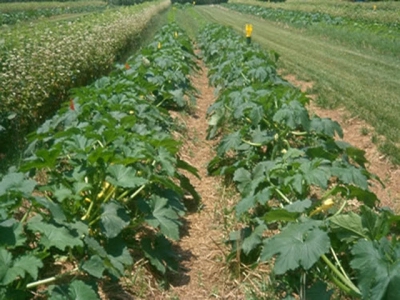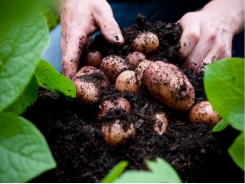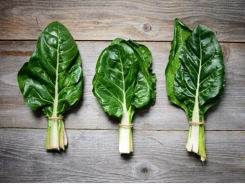Looking after your Cucurbits

It’s important to get the timing right for post-planting nitrogen, cultivation and irrigation if you want to optimise Cucurbit production.
Once pumpkins start wilting like this, much damage has already been done.
Let’s start with nitrogen. Once the plants are on the go, you need to determine if a nitrogen dressing is necessary. It will help, of course, if you have experience of the ground where the crop has been planted. Keep in mind that when nitrogen is in a nitrate form, it becomes part of the soil solution and leaches through easily. The amount leached will depend to some extent on the soil type and its organic content.
Sandy soils are much more prone to leaching than clays. But the organic content can minimise this loss in two ways. Firstly, humus has the ability to ‘hold’ on to some nitrate. Secondly, as humus breaks down in cultivated soil it releases some nitrogen as well. This is a gradual process and is unlikely to supply all the nitrogen needed – but it will help.
Vigorous growth
It’s important at this early stage for the plants to grow at a good pace. Any setback will cause uneven development on the land and could lead to lower yields. With this in mind, it’s a good idea to apply a nitrogenous side dressing now. Even if it’s not really needed, the amount supplied at this point is unlikely to have serious consequences. After this, it’s best to apply according to demand.
‘Read’ the plants to see what they’re saying. The leaf colour should be correct for the species. Then there’s the size – leaves will be smaller when nitrogen levels become too low. Remember, though, that nitrogen ‘problems’ almost never affect all plants on the land at the same time. Usually, plants in dips will show the symptoms first. So look in these places first to see if you need to treat the whole land.
If any mechanical cultivation is to be done, monitor the situation daily. Depending on the row spacing of the crop being grown, consider doing a shallow cultivation with a tined implement. You can, in some cases, have the tractor drive between the rows or straddle the row with the cultivator set to cultivate either side of the row.
It’s important to time this operation well, as a few days’ procrastination may mean that you are unable to proceed. This is because, at this stage, the crops grow very rapidly into open ground. As it is, even if your timing is right, you’ll probably need someone going ahead of the tractor and moving the runners a little to the side to prevent damage to them during the operation.
Establishing the Moisture content
Cucurbits have a large leaf area and draw a great deal of moisture from the soil when they have produced a canopy. Again, frequent inspections are needed to gauge the moisture content of the soil and watch the leaves. As with nitrogen, the first symptoms that the plants require irrigation will show up in patches. Ideally, you should be able to identify the problem by the appearance of the leaves, before any wilting occurs. Have a close look at the condition of the leaves just before irrigation and then again afterwards. This is easier if you’re irrigating one part of the land only.
Even after a relatively short time, you’ll be able to see a distinct difference between leaves that have received water and those that haven’t. The former will have a glossy appearance, while leaves that need water have a duller colour. This applies not only to Cucurbits, but to most other crops as well. After a while you’ll be able to easily determine the water requirements of your crop.
Related news
Tools

Phối trộn thức ăn chăn nuôi

Pha dung dịch thủy canh

Định mức cho tôm ăn

Phối trộn phân bón NPK

Xác định tỷ lệ tôm sống

Chuyển đổi đơn vị phân bón

Xác định công suất sục khí

Chuyển đổi đơn vị tôm

Tính diện tích nhà kính

Tính thể tích ao




 Spacing of Cucurbitaceae
Spacing of Cucurbitaceae  7 Amazing Benefits Of Swiss Chard
7 Amazing Benefits Of Swiss Chard